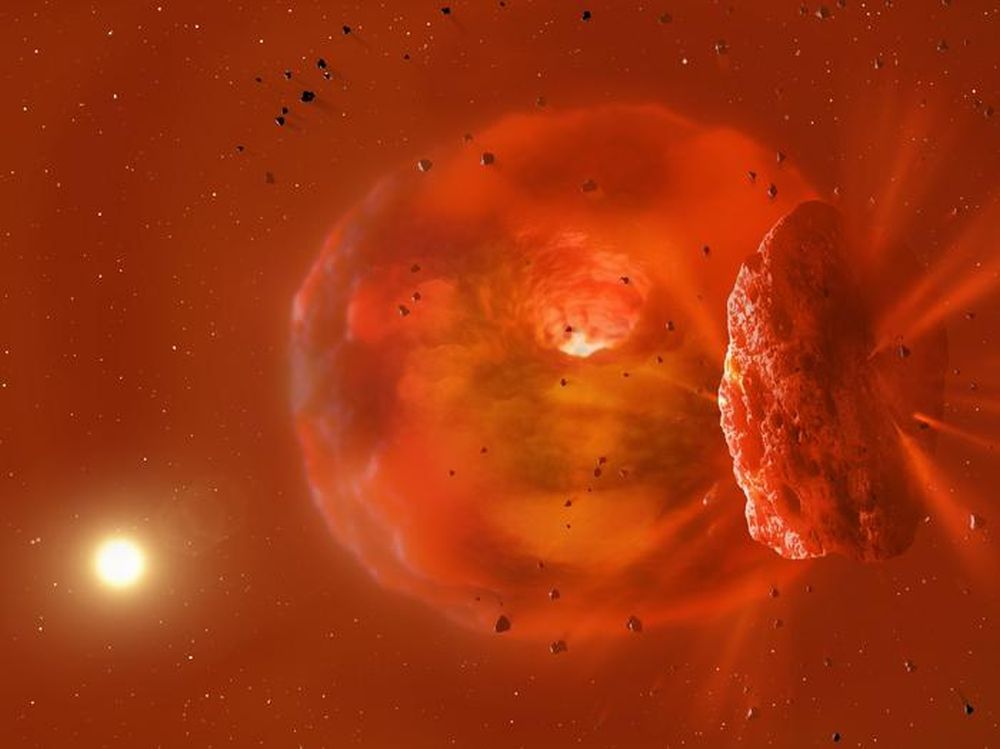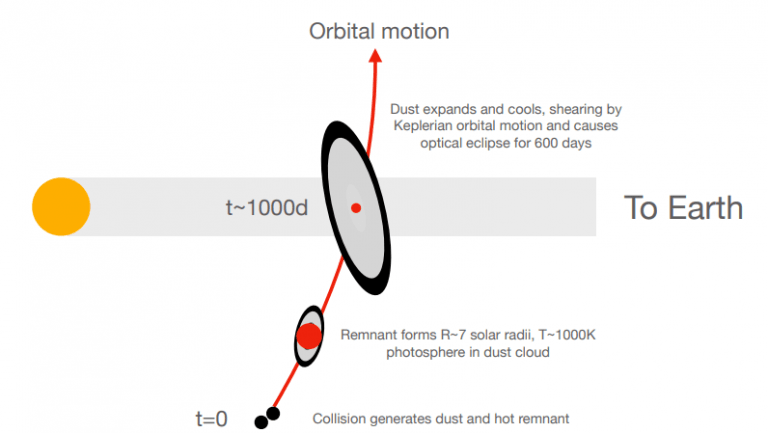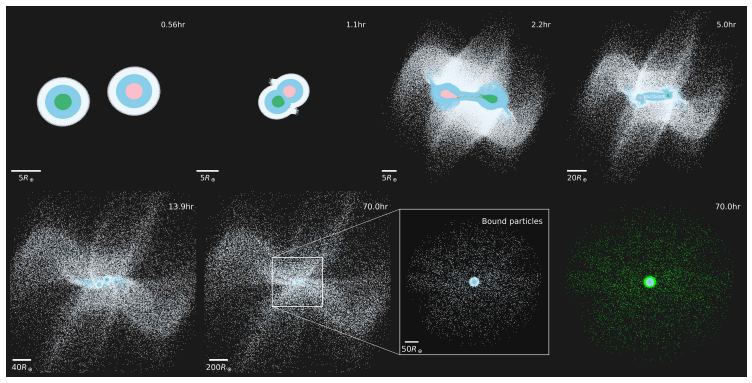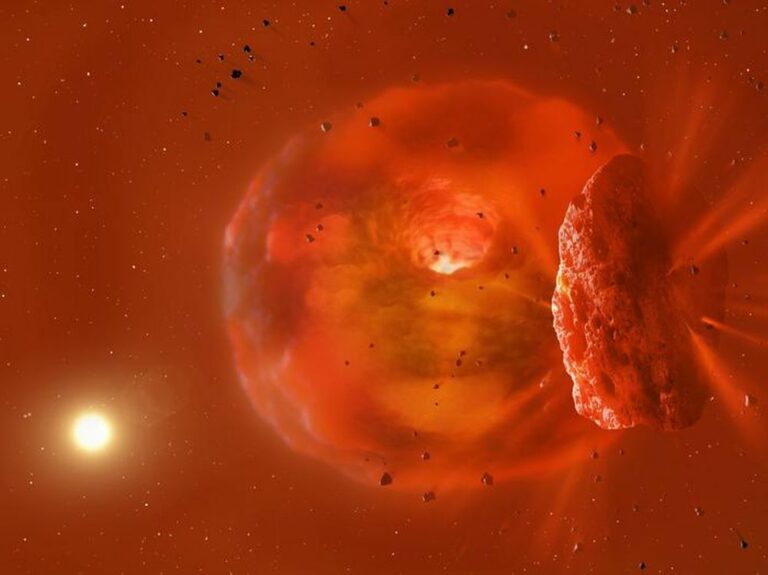Uncovering the First Signs of a Collision Afterglow from a Massive Exoplanet
“What would occur if two massive planets collided, a potentially awe-inspiring event should it take place within our Solar System? Consider the scenario where Neptune and Uranus collide, leading to the emergence of a super-heated entity in their wake and the obscuring of the Sun by clouds of debris. Envision the immense devastation as celestial bodies collide in a chaotic display.
Astronomers recently detected the consequences of a colossal planetary collision in a distant solar system. Instead of being terrified, they were filled with surprise and intrigue, observing the aftermath from a safe distance. Their intention is to continue monitoring the unfolding aftermath.

The story began several years ago when an astute astronomer noticed an anomaly in the light curve of an otherwise typical star. Infrared light abruptly intensified, persisting for approximately 1,000 days. Subsequently, a phase of optical dimming commenced in December 2021 and continued for roughly 500 days. This peculiar light curve captured the attention of fellow astronomers.”
An international group of astronomers conducted a thorough examination of the star and its luminosity patterns, subsequently sharing their findings in the scientific journal Nature. The study, titled “An Afterglow of Planetary Collision and Transit of Resulting Debris Cloud,” is led by Dr. Matthew Kenworthy of Leiden University and Dr. Simon Lock, a Research Fellow in Earth Sciences at the University of Bristol.
The fluctuations in the star’s brightness were initially identified by the All-Sky Automated Survey for SuperNovae (ASASSN), which is designed to identify transient light signals indicative of active supernovae. Although the atypical luminosity pattern did not correspond to a supernova, astronomers immediately recognized its significance and the need for further scrutiny. The Astronomer’s Telegram concurred with this sentiment in their report, stating, “It is highly recommended to conduct follow-up observations of this exceedingly exceptional celestial object,” a sentiment echoed universally within the astronomical community.
Dr. Kenworthy, one of the co-lead authors, shared that an astronomer on social media brought attention to the fact that the star had experienced an increase in infrared brightness over a period of more than a thousand days before undergoing optical fading. This observation, as he pointed out, marked an uncommon occurrence in the celestial realm.
Interest piqued, and Dr. Kenworthy, alongside fellow astronomers, initiated close monitoring of the star, which subsequently received the designation ASASSN-21qj.
Dr. Kenworthy remarked, “To be candid, this discovery took me entirely by surprise. Once we disseminated the visible light curve of this star to the broader astronomical community, we commenced a comprehensive observation campaign utilizing a network of additional telescopes.”

Having gathered an extensive dataset of light curves and observational information, the researchers found themselves initially perplexed by the underlying cause. To gain clarity, they turned to simulations in an attempt to decipher the phenomenon. In the early stages of their investigation, they harbored uncertainties.
They contemplated whether the initial luminosity surge and the subsequent dimming were entirely unrelated occurrences. Additionally, they explored the possibility of a collision between two colossal celestial bodies, which might have generated solely a cloud of debris situated a mere 0.1 astronomical units (AU) from the star.
However, subsequent to in-depth simulations and comprehensive analysis, the researchers arrived at the conclusion that a collision had indeed occurred, but it involved two massive planets positioned several AU away from the star. Each of these planets boasted a mass roughly equivalent to 25 times that of Earth, and the collision occurred at a velocity of 45.77 kilometers per second (km s-1). Remarkably, the collision didn’t just yield debris.
Their findings pointed to a collision between two giant planets, leading to the creation of a novel celestial entity known as a synestia – a rapidly spinning, doughnut-shaped mass of intensely vaporized rock. The surge in infrared emissions, it appeared, was attributed to the intense heat generated by this synestia.
In essence, the collision gave rise to two significant outcomes: a substantial debris cloud and the formation of a new planet-sized entity. Notably, the colliding bodies were both ice-giant planets significantly larger than Earth.

“Our calculations and computer models indicate the temperature and size of the glowing material, as well as the amount of time the glow has lasted, is consistent with the collision of two ice giant exoplanets,” said co-lead author Lock.
These planets were far more massive than Earth, and the energy the collision released would’ve been stupefying. The resulting synestia could’ve been hundreds of times larger than Earth, super-heated, and spinning rapidly. The collision and the resulting object explain the infrared brightening, but what about the dimming period that followed it?
That’s because of the expanding debris cloud. The shower of debris would’ve been equally as spectacular if viewed from a closer vantage point. Alongside the collision and the resulting synestia, the cloud would’ve changed the nature of the solar system. But all astronomers could see was the optical dimming as the cloud passed in front of the star three years after the infrared-bright period. We can only imagine what it might’ve looked like.

As time progresses, the cloud will undergo elongation as it orbits the star in the company of the celestial body resulting from the collision. This elongation will disperse the star’s light, and advanced telescopes such as the James Webb Space Telescope (JWST) are expected to provide us with additional insights. Furthermore, the synestia will gradually cool and eventually evolve into a new planet in orbit around the star, giving rise to the possibility of the emergence of new moons.
Co-author Dr. Zoe Leinhardt expressed her excitement about these forthcoming developments, stating, “It will be truly captivating to observe the ongoing transformations. Ultimately, the mass of material encircling the remnants may coalesce to form a retinue of moons that will revolve around this nascent planet.”

How did these events transpire?
ASASSN-21qj, with an age of approximately 300 million years, reached a point in its development where the gas component within its protoplanetary disk had largely dissipated. This depletion of gas makes occurrences like the observed collision more probable. Our own Solar System underwent a comparable event in its early history, where a collision transpired between Earth and the protoplanet Theia, creating a vaporized cloud that ultimately coalesced into the Earth and the Moon. It is likely that such collisions occurred during the formative years of our Solar System.
What astronomers are witnessing in the case of ASASSN-21qj is a parallel phenomenon but on a much grander scale. While continuous observation will likely reveal the elongation of the dust cloud, it will take a substantial amount of time for the precise nature of the resultant planet and any moons to become evident. At present, we rely on theoretical models, which are not particularly reliable in this specific scenario.
The authors acknowledge the limitations of SPH (smoothed particle hydrodynamics) simulations, stating, “It is not feasible to accurately determine the initial structure of post-impact bodies in the relevant regime.”
In essence, it will require prolonged observation of this system to uncover the eventual outcomes and the type of planet that forms. However, it remains uncertain whether humanity will endure long enough to witness these developments. Yet, there is hope that astronomers may not need to wait indefinitely. By identifying more of these unique light curves, particularly with the forthcoming Vera Rubin Observatory specializing in detecting such transient events, astronomers could gain insight into these collisions, their prevalence, and the types of celestial objects they give rise to.
Source: UniverseToday
Do not forget to share your opinion with us to provide you with the best posts !




0 Comments